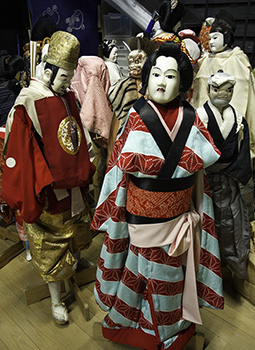Home > Highlighting JAPAN > Highlighting Japan July 2017 > Evolving Traditions
Highlighting JAPAN




“Living” Dolls
Awaji ningyo joruri is enjoying a revival and inspiring creators overseas.
Awaji ningyo joruri (Awaji puppet theater) has a history of over 500 years and is a designated Important Intangible Folk Cultural Property of Japan. Originating as its name suggests on the island of Awaji in Hyogo Prefecture, this form of puppet theater spread throughout the country to become a traditional Japanese performing art. Often invited to perform overseas, the Awaji Puppet Theater Company has also influenced creators far beyond Japan’s shores.
Ningyo joruri generally involves the interplay of shamisen, which produces deep tones when its three strings are plucked with a bachi (plectrum), the joruri (narrative) of the tayu (chanters), who describe the emotions of the various characters and tell the story, and the puppets, which portray human relationships as though they are actually alive.
In the eighteenth century, ningyo joruri was hugely popular, and numerous puppet theater troupes, big and small, were formed and became much loved by ordinary people.
Traditional puppet theater is said to have its roots in the aforementioned Awaji ningyo joruri of Awaji Island. Awaji Island once had over forty puppet theater groups, which toured throughout Japan spreading ningyo joruri. Bunraku, the most famous form of ningyo joruri today, has its roots in Awaji.
However, once so popular, ningyo joruri has been in decline more recently, pushed out by various forms of entertainment and culture. In the first half of the twentieth century, even Awaji ningyo joruri started to die out. However, thanks to the efforts of people who wanted to preserve the tradition, the Awaji Puppet Theater Company was formed in 1964 and, with the cooperation of one city and ten villages (now three cities), the Association of Awaji Ningyo Joruri was established. The Awaji Puppet Theater Company has since been invited to perform in a total of thirty-five countries, including Russia, the United States and countries in Europe, Asia and Oceania, and has been highly acclaimed throughout the world.
What Is Awaji Ningyo Joruri?
Awaji Puppet Theater Company manager Chiaki Bando explains some of the background to Awaji ningyo joruri.
“One of the features of Awaji ningyo joruri is that it is strongly colored by Shinto rituals. The lives of the people on Awaji have always revolved around farming and fishing and have been greatly affected by nature, and the puppets were used to appease the gods. The Ebisu-mai (Ebisu puppet dance) that is performed at fishermen’s festivals for example has been passed down from generation to generation.
“The puppets used in these Shinto rituals were combined with the shamisen and a spoken narrative, and Awaji ningyo joruri was born. On Awaji Island, the custom of performing the Shiki Sanbaso Dance at shrines to mark Japanese New Year still survives today.
“Another feature of Awaji ningyo joruri is the large size of the puppets, which can be up to 170 cm tall (the puppets used in bunraku by contrast are typically around two-thirds human size). When three puppeteers manipulate this puppet, breathing as one, a life-size puppet starts to move about the stage. The subtlety of the emotions of each puppet is also surprising. They move their eyes from left to right, raise their eyebrows in anger, open their mouths and laugh… the puppets express emotions with extreme subtlety, at times, dynamically. The heads are made of hinoki (cypress) and kiri (paulownia) wood and the hollowed-out inside houses the strings and other mechanisms that make the eyebrows, eyes and mouth move. The part which moves the string-pulling device is called the kozaru.
“Originally, small puppets were apparently manipulated by one puppeteer but, with the demand for more powerful plays, the puppets are said to have changed dramatically.
“Flashy performances which surprise and entertain audiences while at the same time maintaining the flavor of a Shinto ritual can also be said to be characteristic of Awaji ningyo joruri. This includes hayagawari (quick changes of costume), where the costumes of the puppets and the puppeteers change in an instant, and odogu gaeshi (change of setting), where the background of the stage gradually changes and finally a space which looks like a great hall of one thousand tatami mats appears.
“Awaji ningyo joruri has also influenced creators overseas. For example, Julie Taymor, director of the Broadway musical The Lion King, visited the Awaji Puppet Theater to train for around one month after graduating university in 1974. The Lion King scene in which the two lions lean forward to confront each other incorporates movements used in puppet theater to express anger by drawing close to the other person.
“Today, children living on Awaji Island learn about the Awaji ningyo joruri in play groups and junior high school and high school club activities. As members of the Awaji Puppet Theater Company, we are also involved in these lessons. We would like to preserve this 500-year-old tradition and ensure that it is passed on to the next generation,” says Bando.
The Awaji Puppet Theater Company has around twenty members. At the theater completed in 2012, they perform four times a day, every day except Wednesday when the theater is closed. Every year, 50,000 people come to the theater. Once in danger of dying out, this traditional performing art is once again in the limelight.
© 2009 Cabinet Office, Government of Japan






